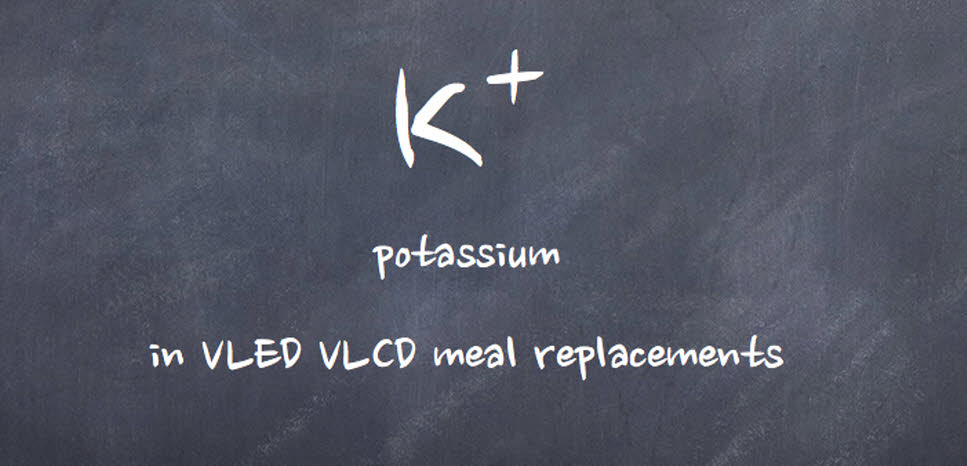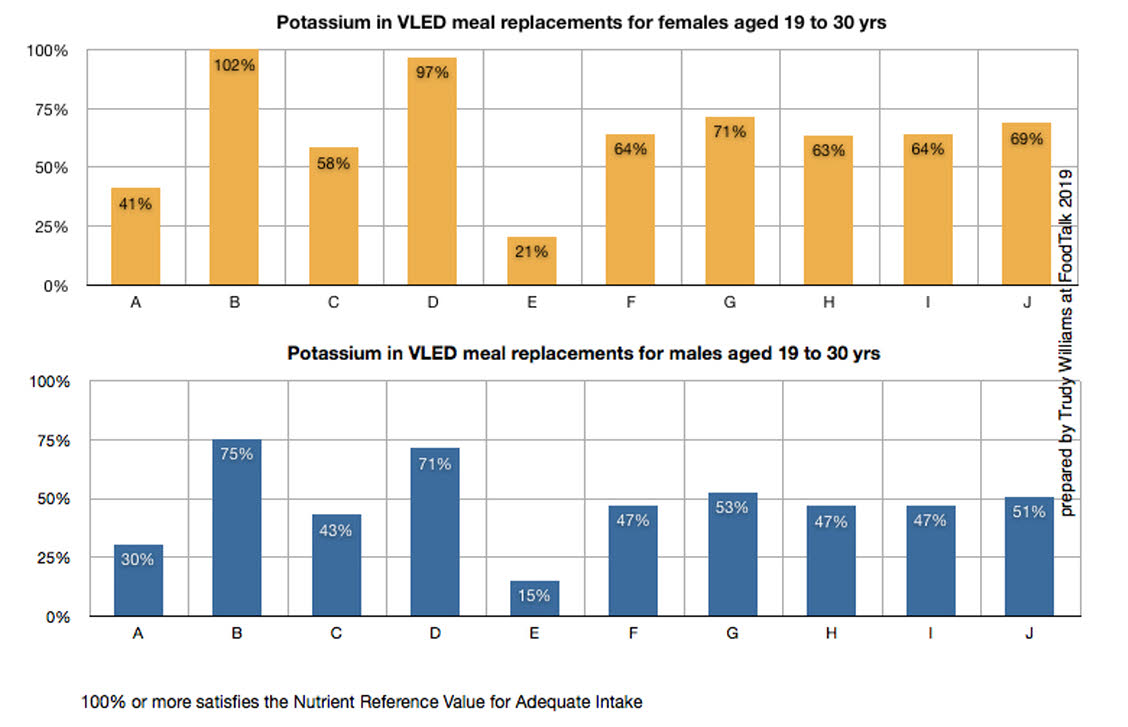why vegetables are compulsory: potassium in VLED VLCD products
And why vegetables are not optional when using meal replacements.

Potassium is an essential mineral found inside cells. The chemical symbol for potassium in K+.
When the blood level of potassium drops too low (hypokalaemia), the heart muscle and nerve cells may not function correctly. A very low blood potassium level is dangerous because it disrupts the regular rhythm and beat of the heart (arrhythmia).
potassium content too low
The potassium content of most VLED VLCD meal replacement products is too low.
Usually an ordinary mixed diet supplies sufficient potassium for most people. Additional potassium is needed by some due to the medications taken. For example, some diuretic medications increase losses of potassium via urine. Diuretics are prescribed for high blood pressure, fluid retention or heart disease. Laxatives may increase losses of potassium via faeces. A low blood magnesium and low folic acid level may also upset potassium balance.
The majority of VLED VLCD meal replacements do not meet the daily Adequate Intake recommendations. Therefore, it is critical to consume additional high potassium, low kJ foods to bump up the intake of potassium to satisfactory levels without stalling weight loss.
light vegetables and salad are rich in K+
The most sensible way to boost potassium intake while using VLED VLCD meal replacements is with cooked, raw or blended ‘light’ vegetables and salad.
‘Light’ vegetables and salad are high in potassium yet low in starch, low in carbohydrate, low in kilojoules. They are a brilliant and essential compliment to VLED meal replacements.
Do not boil or soak vegetables unless you drink the vegetable water (soup is fine) because potassium leaches out into water.
The preferred cooking methods are steamed, microwaved, dry-fried or baked.
If your dietitian or health professional allows you to add a small amount of fat or oil, ask if it’s okay to choose a small amount of avocado flesh, seeds or nuts instead of oil. Avocado, nuts and seeds are excellent low carbohydrate sources of potassium. Like oil, nuts, seeds and avocado will increase the kilojoule intake so check and measure allowed serve sizes carefully.
how much 'light' vegetable to eat?
How much is enough? It depends on your age and gender and which VLED product is used.
The following are general suggestions only. Confirm how much you need to add with your personal dietitian and doctor.
A daily starting amount is 300 g cooked ‘light’ vegetable or leafy green salad.
- The cooked vegetable volume is close to 2 cups, a dinner plate filled.
- Salad vegetable volume is closer to 4 cups. Hint: fill a 1000 ml plastic storage container with leafy green salad vegetables for a good idea of how much this is.
- You may prefer to split the amounts up to have one meal with cooked vegetables, another with salad vegetables.
Choose a variety of different vegetables and salad rather than focus on just one or two varieties.
VLED packaging instructions usually have specific instructions as to which 'light' vegetables and salad to include. For example, some do not recommend peas and turnip. Check the pack’s instructions or speak with your personal dietitian.
But even with the addition of ‘light’ vegetables, some VLED VLCD plans may remain too low in potassium. Extra sources of potassium are needed if you use a low potassium formulation.
Check with your health professional and dietitian for personal advice.
now for some detail
Behind these seemingly brief articles goes a lot of effort. It is not a matter of ‘cut and paste’ content from other websites or authors! Similarly for my books. A few pages of content may take months of research and interpretation.
As an example, here are tables of the numbers I crunched that compare the potassium content declared by manufacturers on their VLED VLCD formulations with Nutrient Reference Adequate Intake Values for males and females aged 19 to 70 years.
A surprising amount of work goes into creating these articles and writing my books. I research the scientific literature, attend conferences, crunch numbers and interpret what I uncover.
100% or more satisfies the Nutrient Reference Value for Adequate Intake.

The potassium levels shown in the tables are averaged from the flavours and styles (e.g. bars, soups, shakes) within a Brand’s range and as consumed three times a day without additional food. The addition of light vegetables helps to improve your total potassium intake but your intake will still fall short if the VLED/VLCD starts with a very low potassium content.
Which bar matches which product?
A. Formulite VLCD Shakes
B. Optifast VLCD Protein Plus Shakes
C. KicStart VLCD Shakes and Soups
D. Optifast VLCD Shakes, Bars and Soups
E. Dr MacLeod’s VLED Shakes, Bars and Soups
F. Optislim VLCD Shakes, Bars and Soups
G. Tony Ferguson VLCD Shakes
H. Proslim VLCD Shakes, Bars and Soups
I. Optislim VLCD Platinum Rapid Formula (made with skim milk)
J. Optislim VLCD Platinum Plus Shakes
NOTE: The charts and interpretation rely on manufacturers’ product information that was sourced and collated in Sept 2019. I clarified aspects of nutrition information when it appeared to be erroneous (e.g. mg used instead of mcg for nutrients) or the nutrient values were vastly different to other flavours and styles within a range but some manufacturers haven’t got back to me yet with answers. I will update these tables and interpretations if and when they get back to me. Clearly, I can not be responsible for errors in the information provided on product labels and subsequent interpretations based on those errors. Formulations also change. Always read instructions provided by the manufacturer. Your personal dietitian and prescribing health professional are in the ideal position to decide what is best for you.
